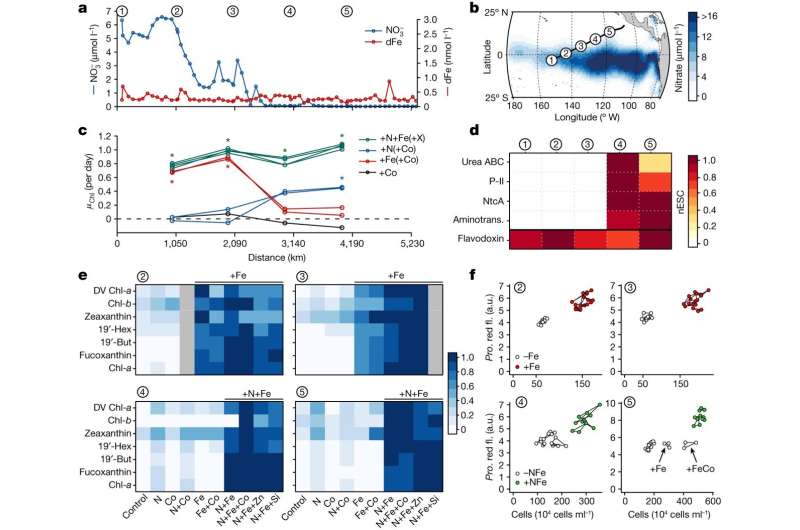This article has been reviewed according to Science X's editorial process and policies. Editors have highlighted the following attributes while ensuring the content's credibility:
fact-checked
peer-reviewed publication
trusted source
proofread
Assessing controls on ocean productivity—from space

Phytoplankton determine how much life the ocean is able to support and play a role in controlling atmospheric carbon dioxide concentrations, thereby regulating our climate. These tiny marine plants depend on sunlight as well as nutrients to thrive—including elements such as iron or nitrogen that can be brought to the ocean surface by currents and upwelling.
To understand phytoplankton nutrient limitations in the ocean, scientists typically conduct experiments during research expeditions at sea. However, this approach documents only a tiny fraction of the ocean at a certain point in time. Therefore, an international team of researchers tested if a signal detected by satellites in space can be used to observe nutrient limitation—covering the whole ocean within a few days.
For this purpose, they investigated whether fluorescence signals from phytoplankton in the Equatorial Pacific recorded by satellites provided information about phytoplankton nutrient limitation. Observations were made on the expedition SO267/2 with the German research vessel SONNE in 2019. In this ocean region, nutrient availability and phytoplankton productivity varies naturally due to the impacts of the El Niño Southern Oscillation (ENSO). The findings are published today in the journal Nature.
"Although satellites have been making fluorescence measurements for two decades, we do not know yet how to properly interpret them," says Dr. Thomas Browning. The marine biologist and chemist at GEOMAR Helmholtz Centre for Ocean Research Kiel (Germany) is coordinating author of the Nature publication and group leader of "Ocean Glow." This project aims to develop new approaches to identify which nutrients are limiting phytoplankton growth from satellite observations.
During the 2019 SONNE expedition, the researchers used experiments and analyses of phytoplankton proteins to figure out which nutrients limited phytoplankton growth. They also evaluated variations in phytoplankton fluorescence—red light emitted from phytoplankton that is thought to be regulated by the nutrients that limit phytoplankton growth.
Specifically, under iron limitation phytoplankton produce pigment-protein complexes that are highly fluorescent, whereas under nitrogen limitation they do not. Importantly, they also made the same type of optical measurements made by the NASA MODIS satellites, by using instruments fitted to the front of the ship looking down at the sea surface. This field data was then compared to satellite data to assess historical trends in nutrient limitation in the Equatorial Pacific since the start of these satellite observations two decades ago.
"We found that phytoplankton were either limited by either iron or by nitrogen, which led to really distinct properties in phytoplankton fluorescence as detected by satellites. We also found that the intensity of iron limitation also influenced fluorescence signals: More intense iron limitation resulted in more fluorescence," says Dr. Browning. Fluorescence observations from the satellites varied in a way that matched the supply of iron upwelled from deeper waters over ENSO cycles.
When they compared their observations to predictions made by a global biogeochemical model, the researchers found a striking difference: Changes in iron limitation were coherent with ENSO dynamics over multiple cycles. But the model overestimated the impact on phytoplankton iron limitation twofold compared to field observations.
In this way, these types of synoptic observations of nutrient limitation from satellites may be key to validating and improving such models—and to better predict the impacts of future climate change on ocean ecosystems.
"These first findings demonstrate how satellite observations can help us assess the impact of nutrient limitations on phytoplankton and their important role in the global ocean and our climate system," says Dr. Browning. "However, our study was focused on the Equatorial Pacific. With the new ERC project 'Ocean Glow,' we plan to validate this much more robustly for all regions of the ocean."
More information: Thomas Browning, Persistent equatorial Pacific iron limitation under ENSO forcing, Nature (2023). DOI: 10.1038/s41586-023-06439-0. www.nature.com/articles/s41586-023-06439-0
Journal information: Nature
Provided by Helmholtz Association of German Research Centres




















